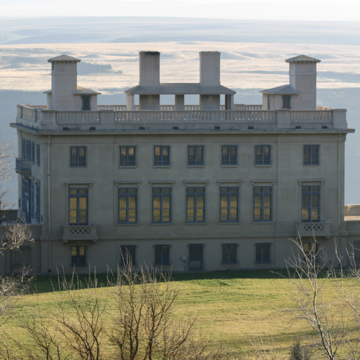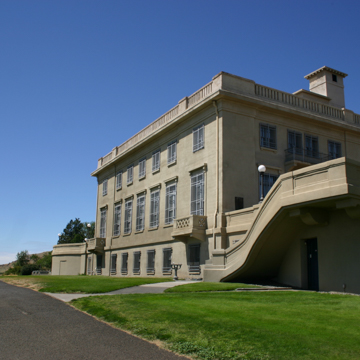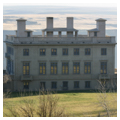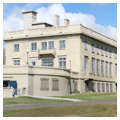You are here
Maryhill Museum of Art
What is now the Maryhill Museum of Art was originally a mansion for Samuel Hill, a wealthy industrialist and railroad builder, who named the building in honor of his wife, Mary. Referred to variously over the years as “Sam Hill’s Folly,” “Castle Nowhere,” a “queer freak of a building,” and “the World’s Most Isolated Art Museum,” today it counts among its diverse holdings works by Auguste Rodin, palace furnishings, personal items of Queen Marie of Romania, and significant examples of Pacific Northwest Native American arts and crafts.
Envisioned by Hill as a palatial residence away from his Portland and Seattle business interests, the mansion was designed by the Washington, D.C. firm Hornblower and Marshall, which had earlier designed Hill’s concrete mansion in Seattle (1908–1910). The two-and-a-half-story, nearly 6,000-square-foot reinforced concrete structure at Maryhill, featuring eight suites, was originally planned to include a grand reception room capable of holding some 250 dinner guests: Hill likely envisioned entertaining politicians, business associates, and the European royalty he had met from several business and philanthropic excursions. Hill also planned for the house to include two elevators (only one was finished but two elevator towers protrude from the roof), and five miles of pipes for gas heating and lighting. Two details stand out: the first are the large entrance double doors, which are made of heavy copper painted with green oxide to resemble green bronze. The second are the east and west ramps designed for automobiles. Each of these ramps terminates in a 60-foot-diameter circular terrace at the second story with a 25-foot diameter circular skylight in the center.
Construction on the Maryhill Mansion began in 1914, but financial difficulties compelled Hill to halt construction by 1917. Hill’s friend Loie Fuller, a famous dancer in Europe, suggested that Hill turn his house into a museum. She secured promises of artwork from Queen Marie of Romania and other officials from foreign governments to help outfit the museum, and on July 4, 1923, Hill signed articles of incorporation for the “Maryhill Museum of Fine Arts”—although the building was only half-finished with no furniture and inadequate plumbing. Nonetheless, in November 1926, Queen Marie, who was in the United States on a goodwill tour, dedicated the Maryhill Museum before an invited crowd of 2,000. The concrete shell— “too sturdy to be a ruin”—stood unfinished until 1938, when funds linked to Hill’s will, who had passed away in 1931, finally became available to complete it. In 1938, the building received electricity, a comprehensive inventory of its collections, and $90,000 to complete the transformation. On May 13, 1940, the Maryhill Museum, now connected by a state highway on the north bank of the Columbia River, opened to the public. Following World War II, the exterior of the building was sprayed with gunite to secure the concrete.
Writing Credits
If SAH Archipedia has been useful to you, please consider supporting it.
SAH Archipedia tells the story of the United States through its buildings, landscapes, and cities. This freely available resource empowers the public with authoritative knowledge that deepens their understanding and appreciation of the built environment. But the Society of Architectural Historians, which created SAH Archipedia with University of Virginia Press, needs your support to maintain the high-caliber research, writing, photography, cartography, editing, design, and programming that make SAH Archipedia a trusted online resource available to all who value the history of place, heritage tourism, and learning.













